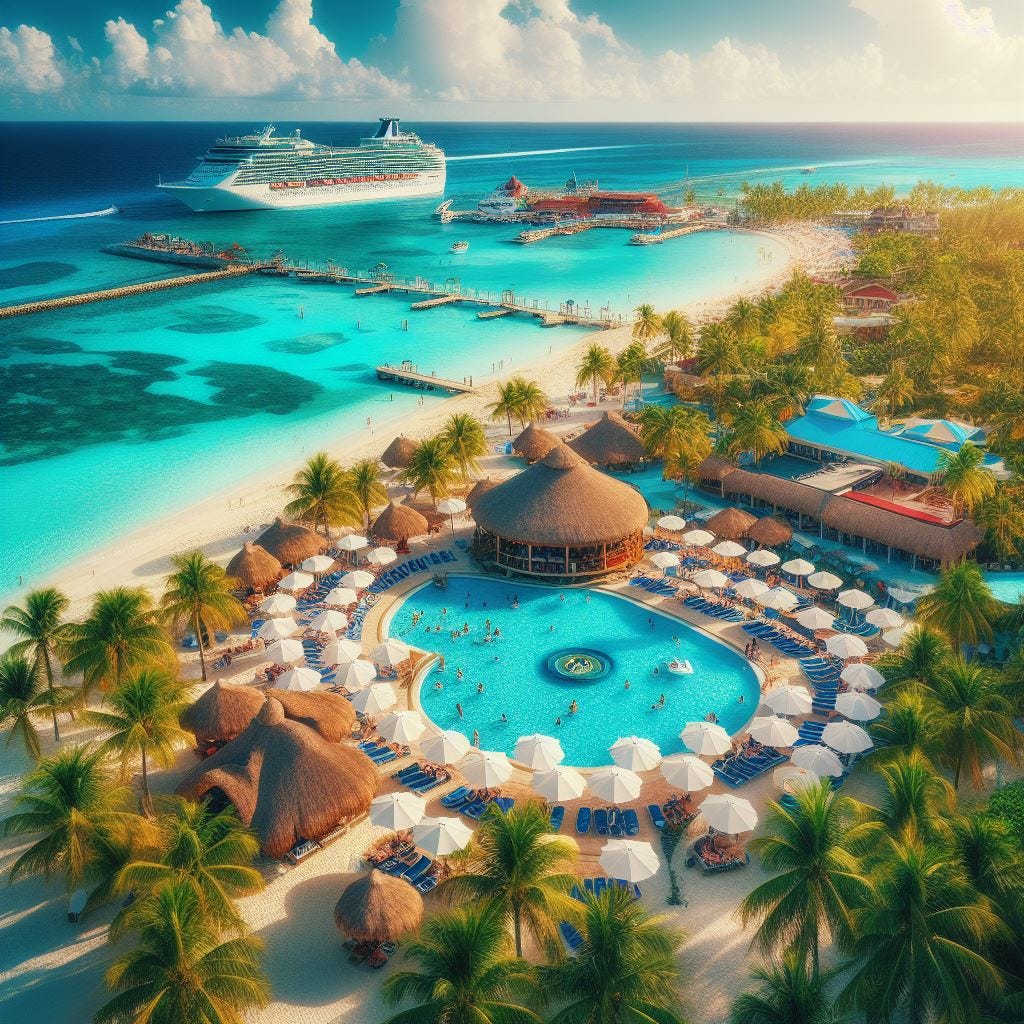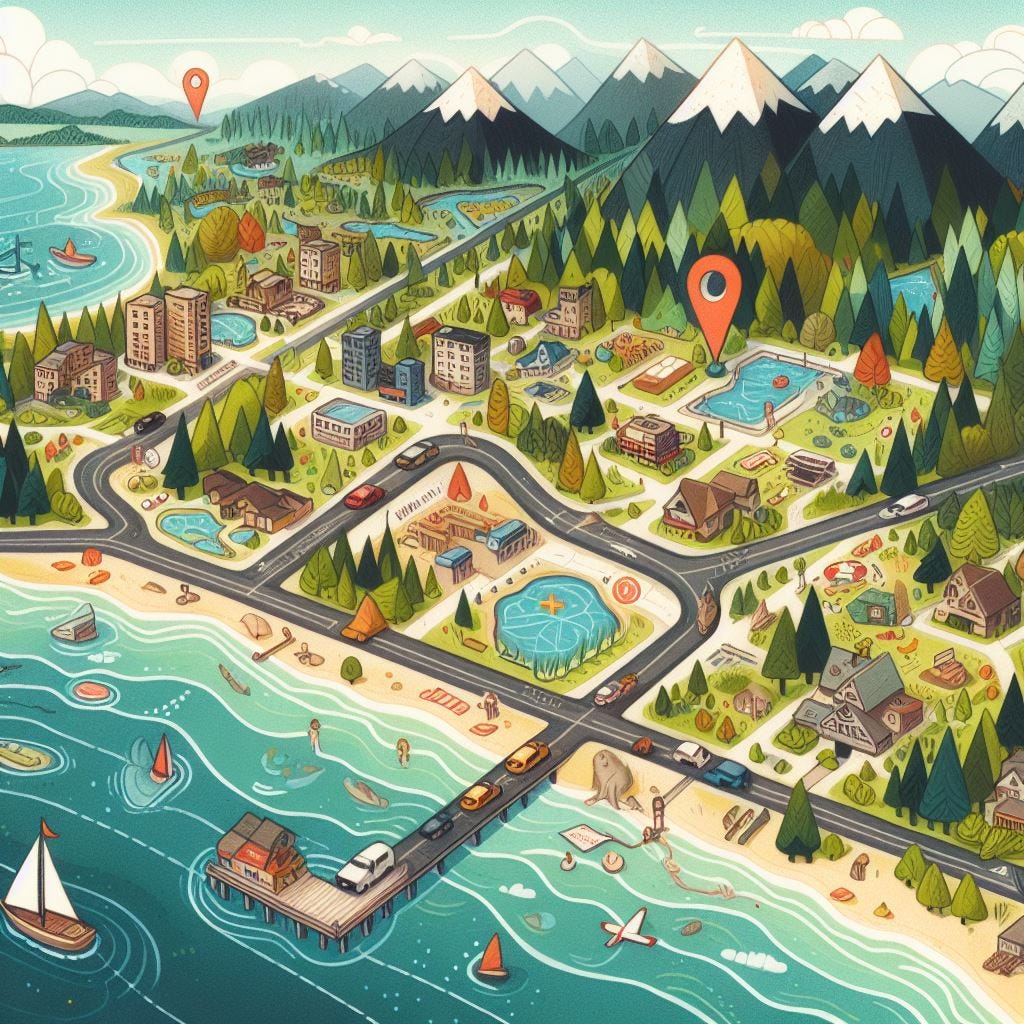The Three Types of Trips You Should Consider
The All/Near-Inclusive, The Single Base, and The Road Trip
When planning your trip, it helps to understand and prioritize how much effort to put into both up-front planning and during-trip opportunities and risks. If you read my last newsletter, you might recall that making certain decisions early, like airline tickets and hotel reservations, is helpful.
That said, everyone is different in terms of their priorities and desires, and categorizing trips into three broad types can help you strategize. In turn that can give you some peace of mind depending on which type might fit you best.
The All/Near-Inclusive: Many are familiar with these types of trips - often to places like the Caribbean and Mexico, plus most cruises. You essentially pay a flat amount up front, and largely gain a “set it and forget it” experience.
The Single Base: You book a specific accommodation at a destination, usually on your own, and use that as your “home base” to explore the surroundings, whether a city, a national park, or a beachfront community.
The Road Trip: Contrary to the name, this type doesn’t necessarily involve you driving cross-country in a car with your family. It’s any trip which involves multiple destinations strung together that require more than just local transportation, and could mean intercity trains, buses, flights, or a rental car. This can open up more things to see and do.
Obviously there are a vast array of trip types and there can be overlap amongst these three, but they provide an easy framework to understand, with each type having its own pros and cons.
The All/Near-Inclusive
Pros:
Prices and schedules largely known and paid up-front, minimizing uncertainty.
Well-developed, mature industry segment
Many quality options to find a fit, including with a travel agent if desired
Safety and security
A predictable product
Cons:
You’re locked into a single resort or ship and may find it too constraining
Despite a variety of experiences and options, it may feel too “standardized”
There are still potential additional charges during your trip that can add up
A predictable product
Let’s be honest, sometimes we don’t want to put too much thought or effort into planning a vacation. Flights, hotels, rental car, what sights to see, what things to do - all those moving parts add up to uncertainty and sometimes stress. You want something that is more “plug-and-play”, both in terms booking and budgeting.
The good news is there is big market segment tailored to this situation - all-inclusive resorts, and their close cousins, cruises. You can think of cruises as “near-inclusive”, as well as land-based resorts that may be similar. With ports-of-call and off-ship/resort excursions, you can have opportunities to explore beyond a pure “all-inclusive” environment.
There’s a wide variety of products and options in this category, whether you’re on a tighter budget or want to splurge, are young and single or in a large family, want to spend just a few days or a week or more. Because these are essentially pre-packaged vacations, they’re also easier to both evaluate on your own quickly, and if desired, work with a travel agent. It’s also a category with a long history and mature companies, with predicable packaged facilities and experiences, so that also leads to less uncertainty. These resorts and cruise ships are also generally safe and secure by design. You can spend less time on budgeting, scheduling, and other “risk management”, and more time learning about and planning activities.
That said, these types of vacations aren’t for everyone, or every time. If you’re the type that like novel, exciting, and new experiences, especially ones that aren’t commonly done, you might have to look elsewhere. These types of vacations tend to centered on Mexico and the Caribbean, at least for North American travelers, although there are all-inclusives and cruises around the world. Finally, despite the large certainty of your expenses up-front, there are often other charges you may not see until during or after your trip, including beverage charges and daily room gratuities tacked onto your bill.
The Single Base
Pros:
Only need to be concerned with one accommodation and booking
Works well in large cities or destinations with good transportation
Works well for shorter-duration stays up to 3 or 4 days
In large cities or otherwise popular destinations, there are be a lot of choices to choose from
Cons:
A poor accommodation experience can negatively affect your whole trip, or necessitating a last-minute change to a different property
You may be limited in terms of the range of experiences a destination can offer, but some destinations like large cities can have many and entail some planning effort.
Need to be aware of full expenses, including fees and taxes, especially for short-term rentals like AirBnB and Vrbo.
In large cities or otherwise popular destinations, there are be a lot of choices to choose from
For other destinations such as national park regions, it may get challenging to find a good single base
This type of trip opens you up to a broader potential set of experiences, especially in large cities like New York or major European cities with well-developed, diversified local transportation options. While such destinations can be vast with a ton of activities, leveraging their density and transit systems can mean not having to hop around between hotels, and comfortably staying in a single good hotel instead. And of course, these types of large, diverse destinations offer a wide range of accommodation types, from YMCA hostels to five-star world-class luxury hotels. The trick will be to wade through the options that fit your budget, family needs, and ultimately a satisfied stay. I personally find TripAdvisor helpful for at least going reviewing guest comments, and many booking sites simply use their ratings anyways. Short-term rentals like AirBnB and Vrbo can work too, especially if you need more space or have more than 4 family members.
At the other end of the spectrum, in certain cases a single base with a car can work well for exploring a single large national park or less-populated region such as the Florida Panhandle or Oregon coast, with the limitation being how many hours per day you’re willing to drive and how many things you want to see before a road trip becomes more efficient. These areas will be more challenging in terms of a large array of accommodation options, as there are usually not large cities in or near them, but they can work if you know your priorities, budget, and can also look short-term rental sites, which can be helpful in areas where there aren’t many good hotel options. With such rentals, you’ll want to be sure you either have restaurants nearby or can purchase groceries and are willing to do some cooking during your trip.
Although the single base is very different from an all/near-inclusive in terms of both the range of accommodations and activities possible, a similar benefit for both of them is you have the peace of mind of returning to a predictable accommodation each day. You can focus on activities and sights in conjunction with or soon after nailing down the accommodation.
That said, there are some risks with a single-base. With more options come more possibility of something going wrong, and you can also get a bit overwhelmed with the range of choices in large cities. A bad hotel or AirBnB may even force you to switch to another accommodation last minute, to avoid ruining your entire trip. It does help to narrow your search with items like budget, traveler rating (again TripAdvisor is great for this), and amenities like a restaurant or free breakfast or a gym.
Location in particular will be very important because you want to be reasonably close and central to the things you want to do. For example, a hotel in or near Midtown Manhattan is helpful if you want to do a Broadway show, see the Empire State Building, and visit Central Park. A home rental in Flagstaff, Arizona is a decent location for accessing the southern rim of the Grand Canyon. A condo in Seaside, Florida is a good location for going up and down the “30A” beach corridor along the panhandle. With more spread-out geographies, you do want to be careful that a single base will not stretch you thin on long excursions and drives, where it might be better to move to a road trip with multiple stops along the way.
Finally, be sure to get the full cost of your accommodation at the time of your booking, especially fees and taxes that may not be included in the “headline” nightly rate. This would include state and local taxes, any resort/amenity fees, and for short-term-rentals, any cleaning and booking platform fees. Those can add up quickly so you’ll want to eliminate any surprises.
More broadly, you’ll want to plan and prioritize your activities accordingly. A single base affords a lot room for flexibility and serendipity, but using the framework I outlined in my last post on "Trip Planning 101", you can prioritize a few things in advance and relax about the rest.
The Road Trip
Pros:
Allows you to see and do more things in a broader geographic area
Can combine multiple types of experiences in a single trip
The most customizable type of trip
Can be more efficient if you are not planning on re-visiting an area again for a long time
A good choice for long, “special occasion” and “memory-making” trips
Cons:
A lot more up-front research and planning, especially without using a travel agent
More moving parts and logistics to book and manage, meaning more uncertainty and potential need for contingency planning
Need at least several days to make it worthwhile without feeling rushed
More potential for your budget to escalate without careful planning
If you’re an American, there’s no more classic vacation type than a road trip. Piling your spouse and kids into a station wagon (or maybe a minivan or SUV today) and heading out on the open highway is still a strong cultural image.
As we’ve become busier and all too often our trips have become shorter, the road trip may have faded as an annual ritual, but it is still a good framework for certain longer vacations. It also doesn’t have to be purely getting your family and suitcase into your four-wheel hauler and driving hundreds of miles between interstate-adjacent motels anymore. You can definitely use more “tools” like “planes, trains, and automobiles” and “hotels, houses, and cabins” on a long, week-long trip. So strictly speaking, a road trip doesn’t have to entail (just) roads. This is especially true overseas where you’re much more likely to use trains, buses, and shorter-haul flights to get around between destinations.
Whereas an all-inclusive resort or cruise is a fairly tightly-curated itinerary, the road trip opens up much bigger possibilities and ones that are more fine-tuned to what you want to see and do. You can fly into a major US city, spend a few nights there, and then explore a nearby national park with a rental car. You could drive to Washington, DC, spend a few days visiting monuments and museums, and then take a train further north to New York Boston for more. Many European trips are essentially road trips too - spend two weeks in Italy and visiting various cities via their extensive rail network. Visit the Greek islands and use ferries to go between them. Maybe even more adventurous would be flying to multiple southeast Asian destinations in a single trip like Singapore, Bangkok, Bali, and Cambodia.
These are great trips for those rare, once-in-a-lifetime experiences you may never get to do again, especially as your kids age and you want make memories with them. Of course you can make an all-inclusive or a single-base trip memorable too, it’s just you can create a much more unique experience with a road trip given enough time.
The trade-off here is there is potentially much more up-front planning and decisions that need to be done, so you’ll want to carefully invest time to do you research. You may also consider using the help of a travel agent to take the load off of you. Again, it can help to got back to my “Travel Planning 101” post, and prioritize a handful of items instead of trying to plan a detailed itinerary. Transportation and hotels are first and foremost, but it may take some concurrent research on travel times between destinations, other transit/transportation options that may obviate the need for a rental car, tickets and hours of operation to popular sites, etc.
The key item to nail down in a long road trip are dates, destinations, and transportation in between them. Then you can focus on more details like specific accommodations and activities. You may needs a few weeks to go through this, but at some point you’ll have enough (though never perfect) information to finalize your bookings.
If you’ve read this far, I hope you found this newsletter useful. Please leave a comment below or otherwise share your feedback. I’d love to hear your challenges and memories you’ve had on your travels!








